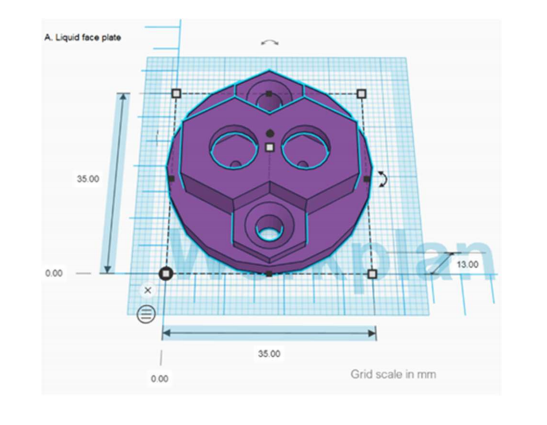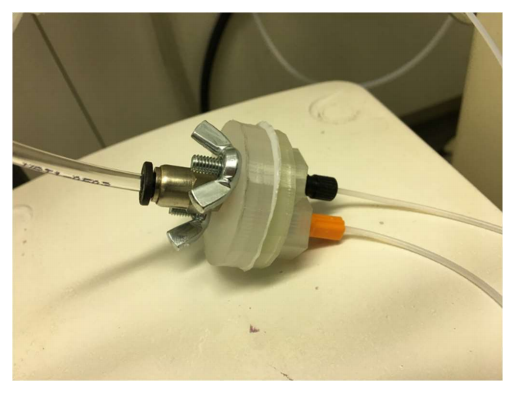David L Walmsley and Emilie Sellier, UK scientists at Vernalis Research, have 3D printed a new device for flow chemistry applications, outlining their study in the recently published ‘Design and Development of a 3D-printed back-pressure regulator.’
With the fabrication of a new back-pressure regulator, the researchers are hoping to improve flow rates in chemistry systems like continuous-flow synthesis. In this study, the authors strive to combine flow chemistry into medicinal chemistry as they refine the ‘unsung hero of flow chemistry,’ for assisting in the transition from a batch reactor to a flow system.
The regulator is required to keep comprehensive pressure, from the pump head, through the reactor, and ultimately the BPR too.
The BPR was 3D printed in two separate faceplates, allowing the researchers to insert hex nuts at the appropriate points and then complete the print, as well as sealing in the nuts. Tinkercad was used for the 3D design of the faceplates for the BPR, along with Cura software, and an Ultimaker 3 for 3D printing.
The chosen material for the BPR was polypropylene (PP), due to its chemical resistance. During the study, the authors were able to fabricate up to nine of the face plates at once on the Ultimaker 3, with only one pause in printing. The researchers listed the following details for the print:
- The liquid face plate’s underside was built onto the print table, resulting in a smooth surface.
- Two slots, rectangular in shape, connected to the membrane, to both liquid input and output.
- Two bolt holes were built into the design for securing both plates together.
- A gas face place was created for one M5 nut to provide a connection to the air supply, via a thread and tubing.
Three samples were built for this study as the researchers studied consistency in each one and how long it took to 3D print.
“Using one face from one of the BPRs as a template, we marked and cut out the shape of the diaphragm out of 0.1 mm thick PTFE sheet. Holes for the M4 bolts to pass through were also marked using the template and then cut out using 4 mm hollow punch. Similarly, we cut out a gasket layer that would be placed on the gas face side of the membrane and cut out the center using a 9 mm hollow punch,” explained the researchers.
The plates were stabilized with two ‘lightly secured’ 2 x M4 stainless steel wing nuts which served to add pressure to the design.
“Fittings for liquid input and output were installed into the liquid face plate and the gas face plate push fit was connected to the regulated gas supply suing 4 mm ID tubing. The BPR was tested for leaks and performance using tetrahydrofuran and acetonitrile as the solvents,” concluded the researchers.
“STL files that can be used to 3D print the Vernalis BPR can be found here. A list of parts and instructions for assembly are included in the files as well as in the supplementary information of the paper, ‘Design and Development of a 3D-printed back-pressure regulator.’”
What do you think of this news? Let us know your thoughts! Join the discussion of this and other 3D printing topics at 3DPrintBoard.com.
[Source / Images: ‘Design and Development of a 3D-printed back-pressure regulator’]
Subscribe to Our Email Newsletter
Stay up-to-date on all the latest news from the 3D printing industry and receive information and offers from third party vendors.
You May Also Like
3D Printing Financials: Fathom Struggles in Financial Quicksand During Critical Transition
Facing a year of key transitions and financial pressures, Fathom (Nasdaq: FTHM) has filed its annual report for 2023 with the U.S. Securities and Exchange Commission (SEC). The document outlines...
Latest Earnings Overview for Australian 3D Printing Firms Titomic and AML3D
Australian 3D printing manufacturing firms Titomic (ASX: TTT) and AML3D (ASX: AL3) reported their financial results for the period from July to December 2023, marking the first half of their...
3D Printing Webinar and Event Roundup: April 7, 2024
Webinars and events in the 3D printing industry are picking back up this week! Sea-Air-Space is coming to Maryland, and SAE International is sponsoring a 3D Systems webinar about 3D...
3D Printing Financials: Unpacking Farsoon and BLT’s 2023 Performance
In the Chinese 3D printing industry, two companies, Farsoon (SHA: 688433) and Bright Laser Technologies, or BLT (SHA: 688333), have recently unveiled their full-year earnings for 2023. Farsoon reported increases...



































